Trying to figure out the meaning behind many of these place names can get tricky. There are different versions drawn from stories people tell, scattered bits in one book or another, entries in vocabularies, and what you happen to stumble upon while digging. And honestly, there’s nothing like diving in and comparing notes… even if sometimes the puzzle pieces seem to fit more by sheer will than solid evidence.
Take Capacuaro, for example. According to the book Toponimia Tarasco-Hispano-Nahoa by Lic. Cecilio A. Robelo, the name means “place of honey bees.” Dr. Antonio Peñafiel’s Geographic Nomenclature of Mexico backs this up, stating that it comes from capari, a type of bee. However, when this community was chosen to host the Kurikuaeri K’uinchekua (New Fire Ceremony), they shared another version — that K’apakuarhu means “place where the hills come together.” That’s where things get fuzzy: if “to gather” is kurhitani or tánani, and “hill” is juata, where’s the connection? Unless tacurani acapacuni (“to stitch one thing to another”) has something to do with it? Anyone care to weigh in?
The same goes for Uaianarhio, Guayangareo, or Morelia, which is often said to mean “flat long hill.” But surprise! If “hill” is k’úmsta and “long” is iósti, then… is this a translation error? A kind of urban legend? A linguistic mash-up? Once again, we’re calling for help from native speakers to pull us out of this etymological pit.
Ichán is another curious case. I was told it comes from Íichan (“these ones”), referring to when the people from Eraxamani (“those who walk a straight path”) settled in what’s now the town. Their neighbors from Tacuro (Tecolote) and Huancito (Habla) supposedly said: “this land will be for these ones.” But where’s the written record of this juicy historical gossip?
Speaking of gossip, Carapan has its own soap opera. Some say it comes from carani (“to write”) or cararani (“to go up”), pointing to the way the land rises toward the mountains. But the books — always dramatic — claim it comes from caras (“worms”). Was there a long-forgotten infestation? Or just a phonetic misunderstanding?
Tanaco and Tanaquillo are also part of the mystery. Are they versions of the same root? Or two independent names derived from… what exactly? Meanwhile, Acachuén swings between two theories: the academic one, linking it to Acahuequa (“cacles” or sandals), and the more popular version, which combines the Spanish “acá” with chéni (“to be afraid”). A place of shoes — or sudden frights? You decide!
Urén doesn’t fall behind (pun absolutely intended). Could it come from urhepani (“to go ahead” or “to lead”) or from uri (“nose”), metaphorically meaning “tip” or “what goes first”? Hey, even a nose points the way, so maybe the ideas aren’t so far apart…
And then there’s Tangancícuaro, king of creative interpretations. Some say it means “place where three waters meet,” while I personally suspected it came from tangaritani (“to throw something forward”). But the texts, like those of Father Lagunas, point toward thangatzeni (“to drive something into the ground”) or thangatzecua (“a stake in the ground”). So, are we talking stakes, water, or visions of the future?
Camécuaro, on the other hand, seems simpler. The books say it’s “place of a certain herb called cami.” But now that I think about it, what herb was that? A sacred one? Medicinal? Or just whatever happened to grow wild?
As we keep debating, let’s remember: toponymy is a minefield of speculation, where even a “nose” might point the way to a leader. And if anyone takes offense at our musings, we can always say: “I read it in a book… or a neighbor told me!” In the end, the real joy is in the search — and in the inevitable moment someone shows up to passionately correct us.






